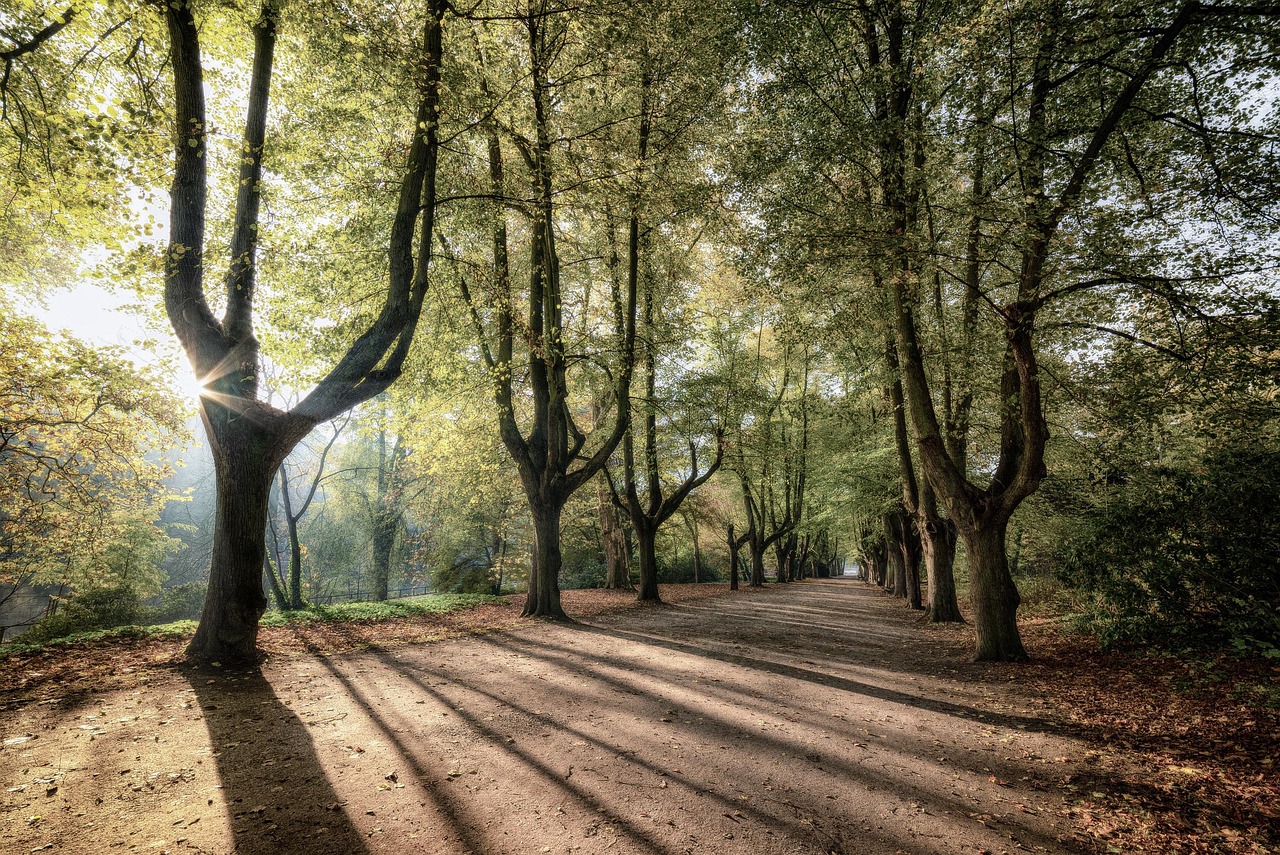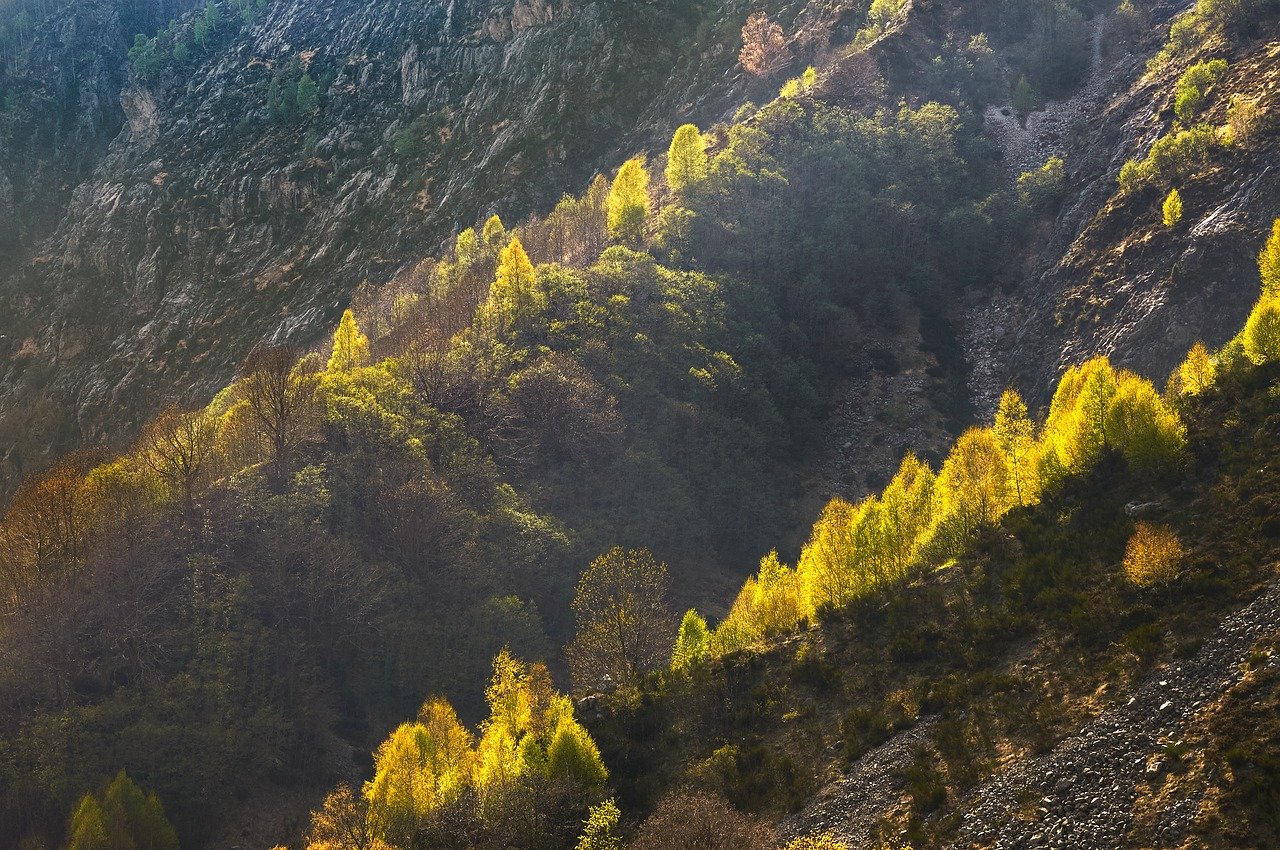The shadow of a tree significantly influences the growth of nearby plants by altering light availability, temperature, and moisture levels. These factors can either hinder or promote the growth of understorey vegetation, depending on the species and their specific adaptations to shaded environments.
Trees play a vital role in ecosystems. They provide habitat and food for various organisms. Additionally, they affect the microclimate around them. The area beneath a tree’s canopy is often cooler and more humid than the surrounding area. This difference in environmental conditions can impact the growth patterns of nearby plants. Understanding this relationship is crucial for ecologists and gardeners alike.

Sunlight is a critical factor for photosynthesis, the process by which plants synthesize food. When trees cast shadows, they reduce the amount of sunlight that reaches the ground below. This can create a competitive environment where only shade-tolerant species thrive. Conversely, sun-loving plants may struggle to survive in these shaded areas.
The Role of Light in Plant Growth
Light is essential for plant growth. Different plants have varying light requirements. Here are some key points about how light affects plant growth:
- Photosynthesis: Plants convert light energy into chemical energy, which fuels their growth.
- Shade Tolerance: Some plants can thrive with minimal light. These are known as shade-tolerant plants.
- Competition: In shaded areas, plants compete for limited light resources.
- Growth Rates: Light availability influences how quickly plants grow. More light typically leads to faster growth.
The ability of a plant to adapt to varying light conditions is crucial for its survival. For instance, some species develop larger leaves to capture more sunlight in shaded areas. Others might grow taller or spread out their branches to reach available light.

Temperature and Moisture Effects
In addition to light, temperature and moisture levels also play significant roles in plant growth under tree canopies. The shaded area tends to have different temperature and moisture dynamics compared to open areas. Here are some factors to consider:
| Factor | Under Tree Canopy | Open Area |
|---|---|---|
| Temperature | Generally cooler | Typically warmer |
| Moisture | Higher humidity, more moisture retention | Lower humidity, faster evaporation |
| Soil Conditions | Often richer in organic matter | May have less organic matter |
The cooler temperatures in shaded areas can slow down the growth rates of certain plants. However, increased moisture retention can benefit species that require more water. This creates a unique ecological niche where specific plants can flourish while others may fail to thrive.
Furthermore, trees can alter soil composition over time through leaf litter and root systems. This process enriches the soil beneath them and can create favorable conditions for certain plants while making it challenging for others that prefer drier or different nutrient conditions.

Interactions Between Tree Shadows and Nearby Plants
The interactions between tree shadows and nearby plants are complex and multifaceted. For instance, trees can create a microhabitat that supports specific flora while limiting others. This dynamic is particularly important in forest ecosystems where biodiversity plays a crucial role in overall health.
Certain species have developed unique adaptations to thrive in shaded environments. For example, many ferns and shade-loving wildflowers exhibit characteristics that allow them to maximize photosynthesis even in low-light conditions. These adaptations can include:
- Larger leaf surface area to capture more light.
- Faster growth rates during the spring when light is available.
- Flexible growth patterns that allow them to adjust their structure based on light availability.
Understanding these interactions helps researchers and gardeners make informed decisions about planting and landscape management. By recognizing how tree shadows influence nearby plants, we can cultivate healthier ecosystems and promote biodiversity.

Tree Canopy Structure and Its Effects on Light Penetration
The structure of a tree’s canopy significantly impacts how light penetrates to the ground below. Different tree species have varying canopy architectures. These differences can create distinct light environments for nearby plants. Understanding these structures helps us comprehend how shadows influence plant growth.
Canopies can be described as:
- Dense Canopies: Trees with thick, closely spaced leaves that block most sunlight, creating deep shade.
- Open Canopies: Trees that allow more light to filter through due to a more spaced-out leaf arrangement.
- Layered Canopies: Multi-tiered structures where different layers of leaves contribute to varying light conditions at different heights.
For example, a dense canopy may restrict light to less than 10% of full sunlight, while an open canopy might allow 30% to 70% of sunlight to reach the ground. This variation directly affects which plants can thrive beneath these trees.
Species-Specific Responses to Tree Shadows
Different plant species exhibit unique responses to the shadow cast by trees. These responses are often tied to their evolutionary history and ecological needs. Some plants have adapted to thrive in low-light conditions, while others may struggle. Below are some examples of how specific plant categories respond:
Shade-Tolerant Plants
Shade-tolerant plants are those that can survive and thrive in lower light levels. They often display adaptations that help them utilize available light efficiently. Common examples include:
- Ferns: Many ferns are excellent at absorbing light in shaded areas due to their broad fronds.
- Wildflowers: Species such as trillium and violets have adapted to grow in the understory, blooming early in the spring before the tree canopy fully develops.
- Ground Covers: Plants like hostas and ajuga grow well in shaded conditions and help prevent soil erosion.
Shade-Intolerant Plants
Shade-intolerant plants require full sunlight for optimal growth. These plants often struggle in the presence of tree shadows. Examples include:
- Sunflowers: These plants thrive in direct sunlight and tend to wilt or fail to grow in shaded conditions.
- Most Vegetables: Many garden vegetables like tomatoes and peppers require full sun to produce fruit effectively.
- Certain Grasses: Species such as Bermuda grass prefer sunny areas and may not establish well in shady spots.
The presence or absence of specific plant species can significantly affect local biodiversity. This dynamic illustrates the importance of understanding tree shadows in forest management and landscaping.
The Impact of Seasonal Changes on Light Availability
Seasons play a crucial role in determining light availability under tree canopies. As seasons change, so do the angles of sunlight and the density of tree leaves. Here are some seasonal effects:
- Spring: As trees begin to leaf out, light availability increases for early bloomers that take advantage of this period.
- Summer: Full leaf density occurs, creating deep shade that limits sunlight for many plants.
- Fall: As leaves drop, more sunlight reaches the ground, allowing late bloomers and ground covers to thrive.
- Winter: In deciduous forests, bare branches allow maximum light penetration, benefiting evergreen species and winter annuals.
This seasonal variability presents both challenges and opportunities for plant growth. Some species have adapted their life cycles to take advantage of these changes, resulting in a diverse range of plant communities.
Management Implications for Gardeners and Ecologists
A proper understanding of how tree shadows influence nearby plant growth is essential for effective landscape management. Here are several considerations for gardeners and ecologists:
- Selecting Appropriate Plants: Choose plants based on their shade tolerance to ensure they thrive in their environment.
- Canopy Management: Pruning trees strategically can increase light availability for nearby plants without compromising tree health.
- Diverse Planting Strategies: Incorporate a mix of shade-tolerant and shade-intolerant plants to create a resilient ecosystem.
- Monitoring Growth Patterns: Regularly assess plant health and growth rates to adjust care as needed based on changing light conditions.
By implementing these strategies, gardeners and ecologists can create healthier ecosystems that support a diverse range of plant life while maximizing the benefits of tree shadows.
Soil Health and Nutrient Dynamics Under Tree Canopies
The presence of trees not only affects light and moisture levels but also significantly influences soil health and nutrient dynamics in the surrounding area. The roots of trees interact with soil organisms and contribute organic matter through leaf litter, which can create a rich environment for nearby plants. Understanding these processes is essential for maintaining plant health in shaded areas.
Here are some key factors that illustrate how trees impact soil health:
- Organic Matter Contribution: Trees shed leaves and branches, enriching the soil with organic material. This process enhances soil fertility and structure.
- Mycorrhizal Associations: Tree roots often form symbiotic relationships with fungi in the soil. These mycorrhizal networks help plants absorb nutrients, especially in nutrient-poor soils.
- Nutrient Cycling: The decomposition of tree litter releases essential nutrients back into the soil, benefiting nearby plants.
- Soil Erosion Prevention: The root systems of trees stabilize the soil, reducing erosion and maintaining soil integrity.
Impact of Tree Species on Soil Composition
Different tree species have distinct root systems and leaf litter characteristics, which can influence the soil composition beneath them. Here are examples of how various tree types can affect soil health:
Deciduous Trees
Deciduous trees, which lose their leaves in the fall, often contribute a significant amount of organic matter to the forest floor. Their leaf litter breaks down quickly, leading to a rich layer of humus that supports diverse plant life. Common deciduous trees include:
- Maple: Known for its nutrient-rich leaves, maple trees enhance soil fertility as they decompose.
- Oak: Oak leaves break down more slowly, contributing to a more acidic soil environment, which can favor certain understory plants.
Coniferous Trees
Coniferous trees, such as pines and spruces, have needles that decompose more slowly than broadleaf trees. This can lead to a less fertile and more acidic soil environment. However, they also provide unique benefits:
- Pine: Pine needles create a thick layer of mulch that helps retain moisture in the soil.
- Spruce: Spruce trees can improve soil structure due to their extensive root systems, which help aerate the soil.
The Role of Understory Plants in Ecosystem Health
The plants that grow beneath tree canopies, known as understory plants, play a critical role in maintaining ecosystem health. These plants contribute to biodiversity and help stabilize the ecosystem by:
- Providing Habitat: Understory plants serve as food and shelter for various wildlife species, including insects and small mammals.
- Preventing Soil Erosion: Their root systems help bind the soil together, reducing erosion caused by wind and water.
- Enhancing Biodiversity: A diverse array of understory plants increases resilience against pests and diseases while promoting overall ecosystem stability.
Interactions Between Light Availability and Soil Nutrients
The interaction between light availability and soil nutrients is crucial for understanding plant growth under tree canopies. When light is limited, plants may rely heavily on the nutrient-rich soil provided by tree litter. Conversely, when light is abundant, plants may use more nutrients for rapid growth. Here’s how these interactions unfold:
- Nutrient Uptake: Plants growing in shaded areas often have adapted root systems that maximize nutrient uptake from the organic layer enriched by tree litter.
- Light-Dependent Growth: In areas with sufficient light, plants can grow faster but may deplete soil nutrients more quickly, requiring careful management.
- Seasonal Nutrient Variation: As seasons change, nutrient availability can fluctuate. Plants must adapt their growth strategies accordingly to optimize resource use.
The Importance of Biodiversity in Shaded Areas
Biodiversity is crucial for the health of ecosystems under tree canopies. A diverse range of plant species can help maintain stability and resilience against environmental changes. Key aspects of biodiversity include:
- Species Interactions: Different plants can support each other through complementary nutrient needs and pest resistance.
- Diverse Root Systems: Various root structures can enhance soil aeration and nutrient uptake efficiency.
- Pollinator Support: A range of flowering plants attracts different pollinators, ensuring reproductive success for multiple species.
This diversity enhances ecosystem resilience, allowing shaded areas to recover from disturbances more effectively. Understanding these dynamics is vital for promoting healthy ecosystems in landscape management practices.
Effects of Climate Change on Tree Canopies and Nearby Plant Growth
Climate change is increasingly influencing ecosystems worldwide, including the dynamics between tree canopies and the growth of nearby plants. As climate patterns shift, the way trees interact with their environment can change, affecting light availability, moisture levels, and soil health. Here are some key aspects to consider:
- Temperature Changes: Rising temperatures can alter leaf phenology, leading to earlier leaf emergence in spring. This can impact the light available for understory plants at critical growth times.
- Increased Drought: Changes in precipitation patterns can lead to drought conditions. Trees may become stressed, reducing their ability to provide shade and moisture to nearby plants.
- Species Migration: As temperatures rise, some tree species may migrate to higher elevations or latitudes. This shift can disrupt established plant communities and create new interactions.
- Pest and Disease Pressure: Warmer temperatures may increase pest populations that affect tree health, potentially leading to less leaf cover and more light reaching the ground.
These climate-related factors can significantly disrupt traditional growth patterns for plants under tree canopies. Monitoring these changes can help in adapting management strategies to sustain plant communities in a changing world.
Utilizing Tree Shadows in Landscape Design
Understanding the role of tree shadows can benefit landscape design and urban planning. Gardeners and designers can utilize tree shadows strategically to create diverse plantings that thrive in varying light conditions. Here are some considerations:
- Creating Microclimates: Use trees to develop microclimates that support a combination of shade-loving and sun-loving plants, enhancing biodiversity.
- Designing Layered Landscapes: Incorporate a variety of plant heights and types to take advantage of different light levels beneath the canopy.
- Integrating Native Species: Planting native species that are adapted to local conditions can enhance ecosystem resilience and support local wildlife.
- Promoting Sustainability: Sustainable practices, such as using compost to enrich soil health, can improve growth for all plants within tree shadows.
By applying these strategies, landscape designers can create beautiful and functional spaces that leverage the natural benefits provided by trees while supporting diverse plant communities.
Final Thoughts
The influence of tree shadows on nearby plant growth is profound and multifaceted. From altering light availability to affecting soil health, trees play a crucial role in shaping the ecological dynamics of their surroundings. Understanding these interactions is vital for gardeners, ecologists, and landscape designers alike.
Key takeaways include the importance of selecting appropriate plants based on their shade tolerance, managing tree canopies for optimal light penetration, and recognizing the role of soil health in supporting plant diversity. Additionally, acknowledging the impacts of climate change on these relationships is essential for sustainable ecosystem management.
Ultimately, fostering a diverse range of plant species beneath tree canopies not only enhances biodiversity but also contributes to the resilience of ecosystems in the face of environmental changes. By integrating these principles into gardening and ecological practices, we can support healthier landscapes and promote thriving plant communities for future generations.
